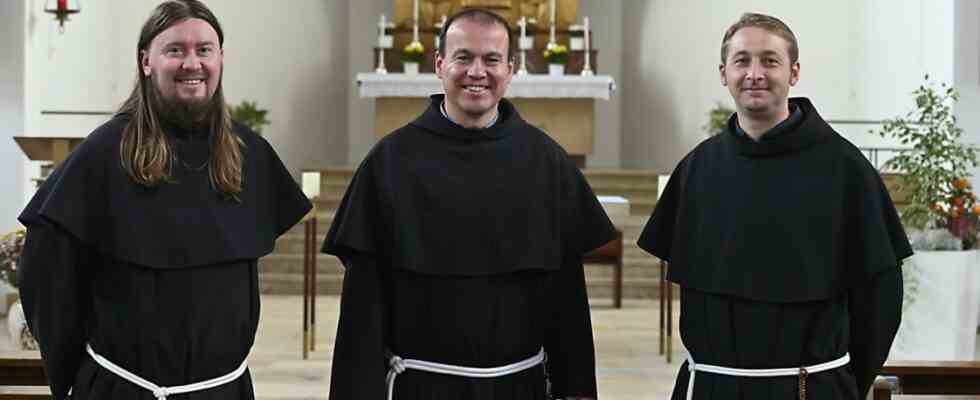Anyone standing in front of the old vicarage in the center of Haar will perhaps be surprised. A stone coat of arms with the inscription “Franziskaner Minoriten” is now hanging to the left of the entrance door. Below the lettering you can see a cross and two arms placed one on top of the other. On the doorbell are the names of the three Franciscan brothers who have been living here since the beginning of October: Father Gabriel Budau, Father Mihai Hortolomei and Father Dan Vătămănelu. Here the new settlement of the Franciscan Minorites has its place in Haar. Not in a defiant monastery building, but in simply furnished rooms next to the parish office of St. Konrad.
What he and his two brothers wanted to build here should be seen as a convent, explains Father Gabriel, as he would like to be called. Konvent is derived from the Latin convivere – to live together and means to live together, pray and organize everyday life. The latter includes pastoral care, i.e. the work in the Haar parish association, of which Father Gabriel has been the leader since the beginning of October. “Our work is two in one,” he smiles: building the convent, with which they were commissioned by their Romanian provincial, i.e. head of the order, and the parish pastoral care as pastor, to which the episcopal ordinariate of the archdiocese of Munich and Freising has appointed them . Both tasks merge into one another. The Franciscan Fathers lead a life as monastic brothers and parish priests at the same time.
Romanian Franciscan Minorites have been represented in Upper Bavaria since 2008, in the province of St. Josef in Grabenstätt (Traunstein district) and in Chieming am Chiemsee, where Father Gabriel has led the Catholic parish association since 2016. Since the rectory in Haar proved to be very suitable for their project, he, Father Mihai and Father Dan moved upstairs, where there is still room for a fourth confrere, whom they want to find. On the ground floor is the public area with a house chapel for the hours of prayer, a kitchen and a meeting room. The latter is their dining room and at the same time a meeting room for community committees. Next door is the parish office.
Fixed prayer times, eating together
Everyday life in the vicarage, which is also their convent, is determined by fixed prayer times, eating together, priestly tasks and many appointments. “My day goes from 7 a.m. to 10:30 p.m.,” says Father Gabriel. And also: “I’ve arrived, I already feel at home here.” The citizens of Haar are curious and friendly. A woman recently stopped her car to greet him. “You can see us, we stand out in our habit,” he says, smiling as he strokes his brown coat with the white cingulum, the cord that serves as a belt. The three knots in it represent their vows of obedience, celibacy, and poverty. He doesn’t own anything, says Father Gabriel, the house, furniture and equipment belong to the church, and the service car also belongs to the community. But he will soon hop on an e-scooter charged with solar power when he has to go to an appointment in his community.
For her, the dual task of founding a convent and looking after a parish at the same time is a sign of the trust and appreciation of the diocese. It is important to him to be available for the people of Haar, for believers as well as for the many full-time and volunteers in the various committees. Finally, he testified that he was willing, as a reliable member of the Ordinariate, to carefully lead the congregation and to take on the priestly duties. To do this, he must know where the shoe pinches and what is accepted. The fact that they put their tables in front of the church for the registration of the new confirmands caused astonishment. Yes, Father Gabriel says with conviction: “We are there, we live with them!”.
A small plaque shows: Here is a settlement of the Franciscan Minorites.
(Photo: Claus Schunk)
The coat of arms of the Franciscans shows the inscription “Franziskaner Minoriten” and below it a cross and two arms placed one on top of the other. The bare arm of Jesus lies over the arm of Francis, who is wearing his habit. Both hands bear the stigmata of crucifixion, although Francis was never crucified. He is said to have received the stigmata on Mount La Verna, 120 kilometers north of Assisi, to which he had retreated in August 1224 in concern for his brotherhood. One day in the morning mist he saw an apparition above him, a six-winged angel fastened to a cross, his companion reported. Shocked and fascinated at the same time, Francis thought about it for a long time. Then the stigmata of Christ appeared on his body. It wasn’t until his death that his followers saw those stigmata. To date, science has not been able to find any proof or counter-evidence for this mystery. For Franciscans, the phenomenon of the stigmata of Saint Francis of Assisi is taken for granted.

